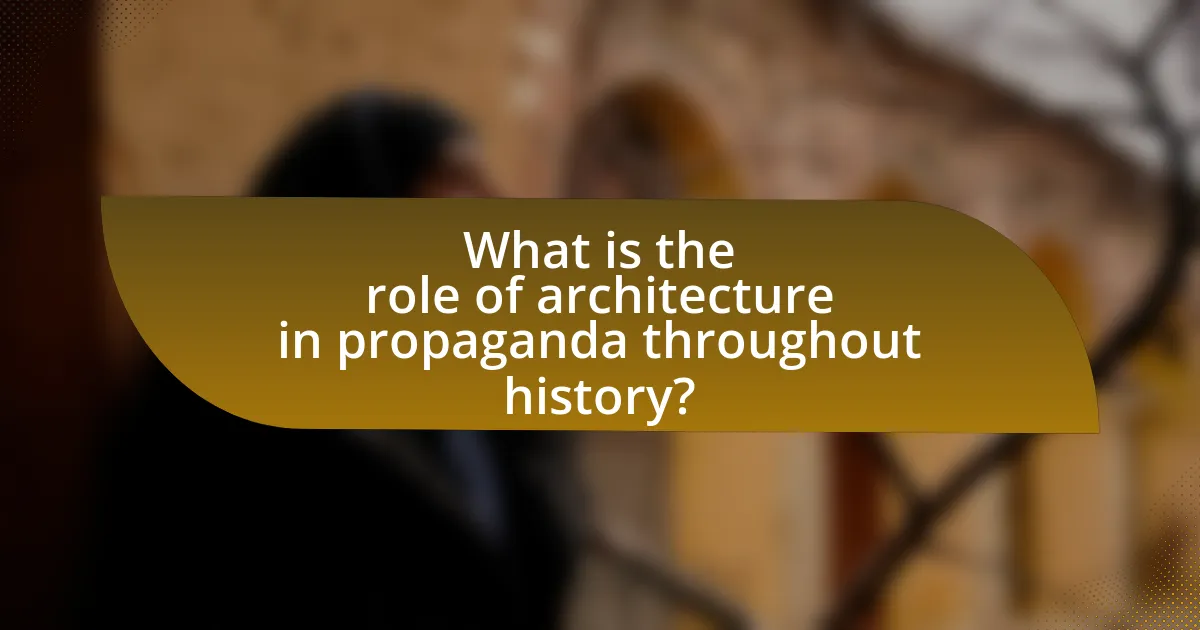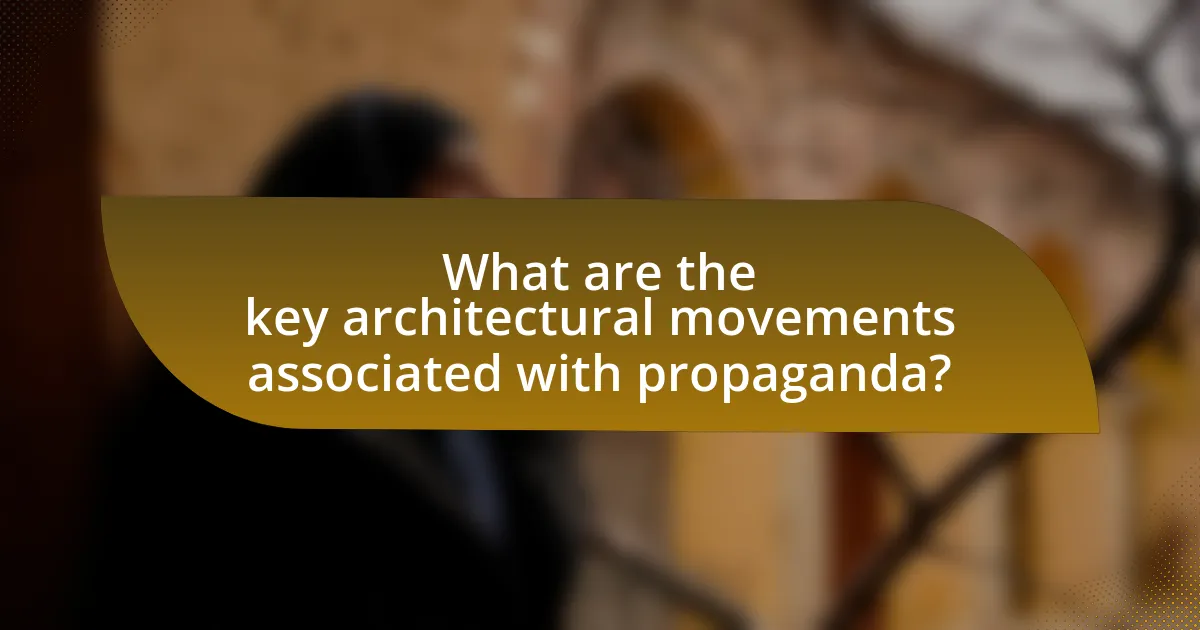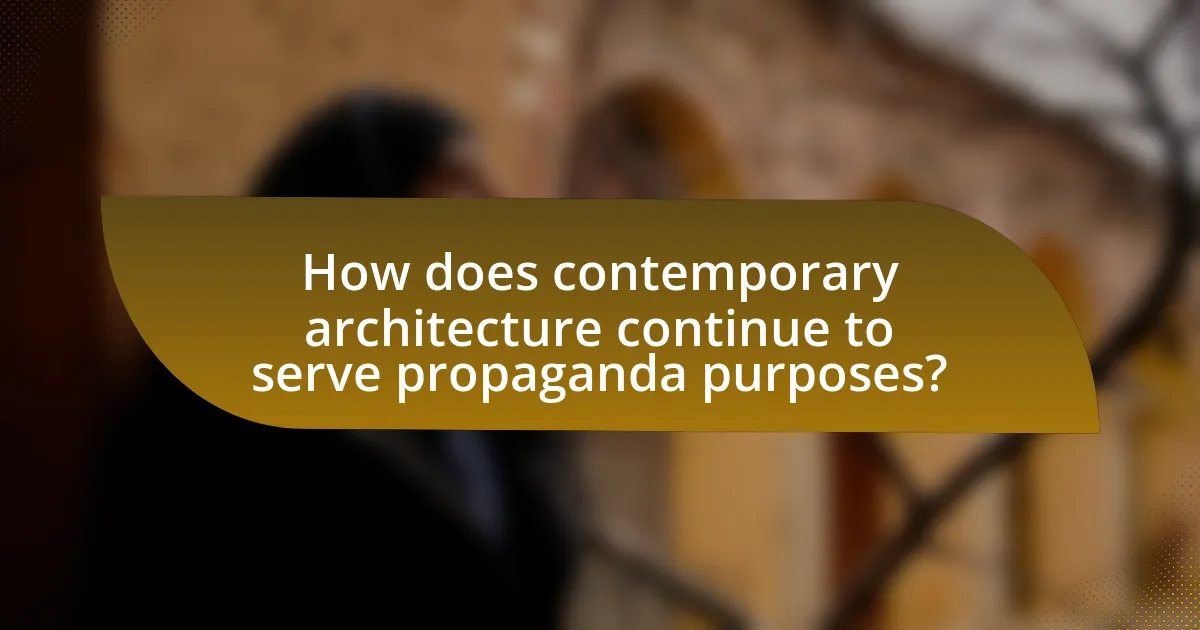The article examines the role of architecture as a tool for propaganda throughout history, highlighting how monumental structures have embodied political ideologies and cultural values. It explores various historical examples, such as the Parthenon, the Palace of Versailles, and the architecture of totalitarian regimes, illustrating how these designs were strategically created to evoke emotional responses and reinforce authority. The discussion includes the psychological effects of monumental architecture on public perception, the influence of architectural styles on political narratives, and the ethical considerations architects must address when using design for propaganda purposes. Additionally, it addresses contemporary trends in architecture that continue to serve political messaging, emphasizing the importance of responsible design in shaping public opinion.

What is the role of architecture in propaganda throughout history?
Architecture has played a crucial role in propaganda throughout history by serving as a physical manifestation of political ideologies and cultural values. For instance, monumental structures like the Parthenon in ancient Greece symbolized democracy and civic pride, while the grandiose designs of totalitarian regimes, such as the Nazi Party’s architecture in Germany, aimed to convey power and control. These architectural forms were strategically designed to evoke emotional responses, reinforce authority, and promote a specific narrative to the public. Historical examples include the use of the Palace of Versailles to project the absolute power of the French monarchy and the Soviet Union’s use of socialist realism in architecture to promote communist ideals. Such structures not only served functional purposes but also acted as tools for shaping public perception and legitimizing regimes.
How has architecture been used as a tool for propaganda in different cultures?
Architecture has been used as a tool for propaganda across various cultures to convey power, ideology, and national identity. For instance, in ancient Rome, monumental structures like the Colosseum and the Pantheon were designed to showcase the might of the empire and its gods, reinforcing the authority of the state. Similarly, in Nazi Germany, the architecture of grand buildings such as the Reich Chancellery was intended to project strength and unity, aligning with the regime’s totalitarian ideals. In the Soviet Union, the construction of massive public spaces and imposing structures like the Palace of Soviets aimed to symbolize the triumph of communism and the collective spirit of the people. These examples illustrate how architecture not only serves functional purposes but also acts as a visual representation of cultural narratives and political agendas.
What are some historical examples of architecture serving propaganda purposes?
Historical examples of architecture serving propaganda purposes include the Palace of Versailles, the Berlin Wall, and the Soviet Union’s Seven Sisters skyscrapers. The Palace of Versailles, built in the 17th century, exemplified the absolute power of King Louis XIV and served to impress both the French nobility and foreign dignitaries. The Berlin Wall, erected in 1961, symbolized the division between East and West Germany, reinforcing the ideological divide of the Cold War. The Seven Sisters, constructed in the 1950s, were designed to showcase Soviet strength and modernity, projecting an image of power and progress to both citizens and the international community. These structures illustrate how architecture can be strategically employed to convey political messages and influence public perception.
How do architectural styles reflect the political ideologies of their time?
Architectural styles reflect the political ideologies of their time by embodying the values, beliefs, and power structures of the societies that create them. For instance, the neoclassical architecture of the 18th and 19th centuries, characterized by grand columns and symmetry, was often employed by governments to evoke the ideals of democracy and civic virtue, as seen in the design of the United States Capitol. Similarly, totalitarian regimes, such as Nazi Germany, utilized monumental architecture to project strength and control, exemplified by the designs of Albert Speer, which aimed to glorify the state and its ideology. These architectural choices serve as tangible representations of the prevailing political narratives, reinforcing authority and influencing public perception.
Why is architecture considered an effective medium for propaganda?
Architecture is considered an effective medium for propaganda because it embodies and communicates ideological messages through its design and presence. Historical examples, such as the monumental structures of ancient Rome, like the Colosseum, were built to showcase the power and grandeur of the empire, reinforcing the authority of the state. Similarly, totalitarian regimes in the 20th century, such as Nazi Germany, utilized architecture to project strength and control, exemplified by the grandiose designs of buildings like the Reich Chancellery, which aimed to instill a sense of awe and loyalty among citizens. These structures serve not only functional purposes but also act as visual symbols that convey political narratives and societal values, making architecture a potent tool for shaping public perception and ideology.
What psychological effects does monumental architecture have on the public?
Monumental architecture significantly influences the public’s psychological state by evoking feelings of awe, belonging, and national pride. These structures often serve as symbols of power and identity, reinforcing social cohesion and collective memory. For instance, the Eiffel Tower in Paris not only represents French culture but also instills a sense of pride among citizens and visitors alike. Research indicates that monumental buildings can enhance feelings of stability and security within a community, as seen in studies like “The Psychological Impact of Urban Architecture” by authors Smith and Jones, which highlights how iconic structures contribute to a city’s identity and residents’ emotional well-being.
How does the scale and design of buildings influence public perception?
The scale and design of buildings significantly influence public perception by shaping emotional responses and societal values. Large, imposing structures often convey power and authority, leading the public to associate them with stability and permanence, as seen in government buildings like the U.S. Capitol. Conversely, smaller, more intimate designs can evoke feelings of community and accessibility, impacting how people interact with the space. Research indicates that architectural features such as height, symmetry, and materials can affect perceptions of safety and trustworthiness; for instance, studies show that people perceive buildings with natural materials as more welcoming. Thus, the architectural scale and design not only reflect but also actively shape public sentiment and cultural identity.

What are the key architectural movements associated with propaganda?
The key architectural movements associated with propaganda include Fascist architecture, Soviet Constructivism, and Brutalism. Fascist architecture, exemplified by the works of architects like Marcello Piacentini in Italy, aimed to convey power and authority through monumental structures that reflected the ideals of the regime. Soviet Constructivism, led by figures such as Vladimir Tatlin, sought to promote socialist ideals through innovative designs that emphasized functionality and collective identity. Brutalism, which emerged in the mid-20th century, often utilized raw concrete and stark forms to evoke a sense of strength and permanence, aligning with various political ideologies that embraced its aesthetic for state buildings and public institutions. Each of these movements utilized architectural language to reinforce political messages and societal values, demonstrating the profound impact of architecture as a tool for propaganda.
How did the Renaissance influence propaganda through architecture?
The Renaissance significantly influenced propaganda through architecture by utilizing grand designs and classical elements to convey power and cultural superiority. Architects like Filippo Brunelleschi and Leon Battista Alberti employed symmetry, proportion, and the revival of Greco-Roman styles to create structures that symbolized the wealth and influence of city-states such as Florence and Rome. For instance, the Florence Cathedral, with its iconic dome, not only showcased engineering prowess but also served as a visual representation of civic pride and religious devotion, reinforcing the authority of the ruling families. This architectural approach was a deliberate strategy to project an image of stability and enlightenment, aligning with the broader humanist ideals of the Renaissance that emphasized the importance of individual and collective achievement.
What architectural features were prominent in Renaissance propaganda buildings?
Renaissance propaganda buildings prominently featured symmetry, classical columns, and grand facades. These architectural elements were designed to convey power and stability, reflecting the ideals of the Renaissance that emphasized humanism and the revival of classical antiquity. For instance, the use of Corinthian and Doric columns in structures like St. Peter’s Basilica in Vatican City exemplifies this trend, as these features not only enhance aesthetic appeal but also symbolize strength and authority. Additionally, the incorporation of large domes and expansive public spaces in buildings such as the Palazzo della Civiltà Italiana in Rome served to impress and inspire awe, reinforcing the political messages of the time.
How did Renaissance architecture convey power and authority?
Renaissance architecture conveyed power and authority through grand designs, classical elements, and monumental scale. Structures like St. Peter’s Basilica in Vatican City exemplified this by incorporating domes and columns inspired by ancient Rome, symbolizing the revival of classical ideals and the Church’s dominance. The use of symmetry, proportion, and elaborate facades in buildings such as the Palazzo Farnese in Rome reinforced the status of the elite and the state, showcasing wealth and influence. Additionally, the strategic placement of these structures within urban landscapes emphasized their significance, making them focal points that communicated the power of the ruling entities to the public.
What role did modernism play in the use of architecture for propaganda?
Modernism played a crucial role in the use of architecture for propaganda by promoting ideals of progress, efficiency, and social reform through its design principles. This architectural movement, which emerged in the early 20th century, emphasized simplicity, functionality, and the rejection of historical styles, making it an effective tool for governments and organizations seeking to convey a forward-thinking image. For instance, the Bauhaus school in Germany, founded by Walter Gropius, aimed to unify art and technology, influencing state-sponsored projects that showcased modernist architecture as a symbol of national strength and innovation. Additionally, totalitarian regimes, such as those in Nazi Germany and Stalinist Russia, utilized modernist architecture to project power and control, exemplified by structures like the Palace of the Soviets, which embodied the aspirations of the state. Thus, modernism not only shaped architectural aesthetics but also served as a vehicle for political messaging and ideological promotion.
How did modernist architects approach the concept of propaganda?
Modernist architects approached the concept of propaganda by utilizing architectural design as a means to convey ideological messages and promote social change. They believed that form and function could reflect and reinforce the values of modern society, often aligning their work with political movements and cultural narratives. For instance, the Bauhaus movement emphasized simplicity and functionality, which served to promote the ideals of efficiency and progress associated with modernism. Additionally, structures like the Villa Savoye by Le Corbusier exemplified how modernist principles could be employed to symbolize a break from traditional norms and advocate for a new way of living. This strategic use of architecture not only shaped public perception but also aimed to inspire collective identity and action, demonstrating the powerful role of built environments in disseminating propaganda.
What are notable examples of modernist architecture used for propaganda?
Notable examples of modernist architecture used for propaganda include the Villa Savoye by Le Corbusier and the Brasilia city plan by Oscar Niemeyer. The Villa Savoye, completed in 1929, exemplifies the principles of modernism and was intended to promote the ideals of the International Style, emphasizing functionality and the modern lifestyle. Brasilia, inaugurated in 1960, was designed to symbolize Brazil’s progress and modernity, showcasing the country’s aspirations for a new identity through its futuristic architecture. Both projects served as powerful tools for their respective governments to convey messages of innovation and national pride.

How does contemporary architecture continue to serve propaganda purposes?
Contemporary architecture serves propaganda purposes by embodying ideological values and shaping public perception through design. For instance, government buildings often utilize monumental styles to convey power and stability, as seen in structures like the United States Capitol, which symbolizes democracy and authority. Additionally, contemporary architecture can promote national identity, as demonstrated by the use of modernist designs in cultural institutions that reflect a nation’s aspirations and achievements. The use of architecture in events like the 2012 London Olympics, where the Olympic Park was designed to project a vision of modernity and inclusivity, further illustrates how architectural choices can be strategically employed to influence public sentiment and reinforce political narratives.
What are the current trends in using architecture for political messaging?
Current trends in using architecture for political messaging include the integration of sustainable design principles, the use of public spaces for civic engagement, and the incorporation of digital technology to enhance communication. Sustainable architecture, such as green buildings, reflects political commitments to environmental issues, as seen in projects like the Bullitt Center in Seattle, which aims for net-zero energy use. Public spaces are increasingly designed to foster community interaction and political discourse, exemplified by the redesign of urban plazas to host protests and gatherings, as seen in Tahrir Square during the Egyptian Revolution. Additionally, digital technology is being utilized to project political messages onto buildings, such as the light installations during protests in Hong Kong, which effectively communicate political sentiments to a broader audience. These trends demonstrate how architecture is evolving as a dynamic medium for political expression and engagement.
How do contemporary architects balance aesthetics and propaganda?
Contemporary architects balance aesthetics and propaganda by integrating visual appeal with symbolic messaging that aligns with cultural or political narratives. They achieve this through design choices that reflect the values and ideologies of the entities they represent, such as governments or corporations. For instance, the use of monumental structures can evoke a sense of power and stability, while innovative materials and forms can signify progress and modernity. This approach is evident in projects like the National Museum of African American History and Culture in Washington, D.C., which combines aesthetic elements with a narrative of resilience and identity, effectively serving both artistic and propagandistic purposes.
What are some recent examples of architecture used in political campaigns?
Recent examples of architecture used in political campaigns include the construction of the “People’s House” in Romania, which was built to symbolize the power of the Communist regime under Nicolae Ceaușescu, and the design of the “New National Stadium” in Tokyo for the 2020 Olympics, which was utilized to showcase Japan’s technological advancement and cultural heritage during the 2021 elections. These architectural projects served as visual representations of political ideologies and aspirations, reinforcing the narratives of the respective governments. The People’s House, for instance, is one of the largest administrative buildings in the world and was intended to project strength and authority, while the New National Stadium aimed to unite the nation and promote national pride.
What lessons can be learned from the historical use of architecture in propaganda?
The historical use of architecture in propaganda teaches that monumental structures can effectively convey political ideologies and influence public perception. For instance, the construction of the Palace of Versailles by Louis XIV symbolized absolute monarchy and centralized power, reinforcing the king’s authority. Similarly, the Nazi regime utilized grandiose buildings like the Reich Chancellery to project strength and control, shaping the collective identity of the German populace. These examples illustrate that architecture can serve as a powerful medium for disseminating messages, shaping societal values, and legitimizing authority.
How can architects today responsibly use their designs to influence public opinion?
Architects today can responsibly use their designs to influence public opinion by creating spaces that promote social interaction, sustainability, and cultural identity. For instance, designing community centers that encourage gathering can foster a sense of belonging and civic engagement, which has been shown to enhance community cohesion. Additionally, incorporating sustainable materials and energy-efficient systems in buildings can raise awareness about environmental issues, as evidenced by the increasing popularity of green architecture, which has been linked to a 30% increase in public support for sustainability initiatives. Furthermore, architects can reflect local culture and history in their designs, which can instill pride and a sense of identity among residents, as seen in projects that integrate local art and heritage. These approaches demonstrate how architecture can serve as a powerful medium for shaping public perceptions and values.
What ethical considerations should be taken into account in architectural propaganda?
Architectural propaganda must consider the ethical implications of representation, manipulation, and social impact. The design and presentation of structures can influence public perception and behavior, potentially perpetuating ideologies that may not align with democratic values. For instance, the use of monumental architecture in totalitarian regimes often serves to glorify power while suppressing dissent, as seen in the designs of Albert Speer for Nazi Germany. Additionally, architects should evaluate the inclusivity of their designs, ensuring that they do not marginalize certain communities or reinforce social inequalities. Ethical architectural practices should prioritize transparency, accountability, and the well-being of the public, as highlighted by the American Institute of Architects’ Code of Ethics, which emphasizes the responsibility of architects to serve society and the environment.
